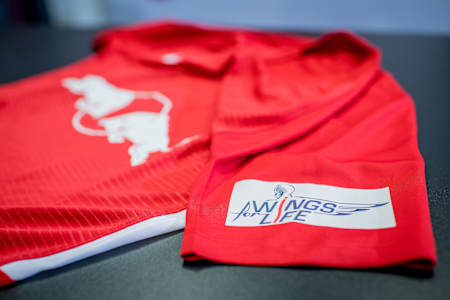
Running
10 incredible highlights from a decade of the Wings for Life World Run
With over a million participants, 119 billion steps taken and $42 million raised for charities, a lot of ground has been covered since the Wings for Life World Run was founded.
Back in 2004, Red Bull co-founder Dietrich Mateschitz and former motocross racer Heinz Kinigadner decided to do something about spinal injury – a crucial ailment that affected not just unlucky extreme athletes, but also millions of children and adults worldwide. The Wings for Life Foundation was born, with the aim of supporting research projects and clinical studies around the world.
A decade later in 2014, Mateschitz and Kinigadner decided to take it up a gear, launching Wings for Life World Run – a one-of-a-kind race that celebrates the compassion of the global sporting community with 100 percent of entry fees and donations going to fund spinal injury research.

2 min
Why we Run Wings for Life World Run
What drives people to participate in Wings for Life World Run? Finding a cure for spinal cord injury is the main cause — so get inspired!
Instead of running from A to B, the Wings for Life World Run has no finish line. Participants around the world set off [at 11am UTC], and run as far and as fast as they can. Then, after 30 minutes, the Catcher Cars sets off. Should the car overtake you, it’s game over. Open to runners of all ages and abilities, the Wings for Life World Run is the only race where everyone is a finisher.
May 7, 2023, marks the 10th anniversary of the Wings for Life World Run – an incredible milestone we can’t wait to celebrate. As the event continues to go from strength to strength, we look back at some of the standout moments – with many more to come.
01
Funding progress
The Wings for Life Foundation was created to cure spinal injury, and a $42 million has been raised in total so far.
To date, 276 different projects have been funded, with 16 new ones since 2022. “These focus mainly on regeneration, reconstruction and secondary damage,” explains Dr Verena May, Scientific Coordinator for Wings for Life.
The race’s popularity is only increasing, too; the Wings for Life World Run 2022 yielded an incredible $5.1 million in donations. As Wings for Life CEO Anita Gerhardter explains, “The more money we raise, the more studies we can help fund – and the faster we can reach our overall goal.”
02
Diverse competitors
The Wings for Life World Run wouldn’t be what it is without you, the competitors. Everyone is welcome at the Wings for Life World Run, and we’ve seen runners in their 80s competing alongside 18 year-olds. It’s an eclectic mix, with top athletes sweating beside novice runners and wheelchair users.
We’ve already seen over one million runners caught up by the Catcher Car. It’s been a hit from the start, too: In 2014, 35,397 runners lined up. Last year, that was up to 161,892 participants from 192 countries.
Oh, and in case you were wondering, all of that adds up to 119 billion steps taken so far.
Everyone, whatever there mobility, is welcome to participate
© Mahmut Cinci for Wings for Life World Run
03
Famous faces
Along the way we’ve attracted more than a few famous faces to take part in Wings for Life World Runs including (deep breath): the president of Slovenia Borut Pahor, Danish surfing legend Bjørn Dunkerbeck, ultrarunner Ryan Sandes, Austrian former World Cup alpine ski racer Marcel Hirscher, FIA World RX Champion Timmy Hansen and Norwegian 400m hurdles world record holder Karsten Warholm.
Even the Oracle Red Bull Racing F1 team has gotten involved. “The Wings for Life World Run is something everybody can get involved in,” said Christian Horner, Team Principal and CEO of Oracle Red Bull Racing. “I’ve participated with the App – and I’m not a runner by any stretch of the imagination.”
Want more famous faces? Go on then. Brazilian soccer player and global superstar Neymar, tennis pros Matteo Berrettini and Stefanos Tsitsipas, skiing great Lindsey Vonn, Dakar Rally legend Cyril Despres and watersport icon Robby Naish have all run – and loved – the Wings for Life World Run, too.
Ultrarunner Ryan Sandes knows a thing or two about running
© Craig Kolesky for Wings for Life World Run
Snowboarder Anne Gasser on Catcher Car duties at the 2022 Vienna event
© Ulrich Aydt for Wings for Life World Run
04
Jaw-dropping locations
One of the best things about the Wings For Life World Run is that it’s a global event, happening at the same time for everyone, no matter where you are. You can even take part on your own, in your pajamas if you like, via the app.
If you want to soak up the official atmosphere, there are seven large-scale Flagship Run events with a real Catcher Car on site. These include runs in Vienna (Austria), Munich (Germany), Zug (Switzerland), Ljubljana (Slovenia), Zadar (Croatia), Poznan (Poland) and Kakheti (Georgia).
And we’ve had many competitors from further afield, too. In ten years we’ve had runners participating with snow-capped mountains, ocean shores, rainy Iceland, snowy Norway or sunny Greece in the background. One woman even ran with the tall grass of the African savannah and a giraffe or two in the background…

3 min
Wings for Life World Run 2022
In 165 countries, 161,892 participants from 192 nations came together for the Wings for Life World Run 2022.
05
Inspiring athletes
As a charity dedicated to curing spinal illness, it’s important to Wings for Life to celebrate differently abled athletes in the Wings For Life World Run. Over the years the run has featured some amazingly inspiring faces, and stories.
In 2018, David Mzee – who's been paralysed for many years – completed a personal milestone when he stood from his wheelchair and covered 390 metres in Zug, Switzerland. The same year, TV presenter Tiphany Adams completed her first Wings for Life World Run, a miraculous achievement after being pronounced dead by the side of the road following a car crash when she was 17.
Discover some of the inspirational stories that make the Wings for Life World Run so special in the video below:

52 min
A Run Like No Other
Discover some of the inspirational stories that make the Wings for Life World Run so special.
The event has also hosted more than its share of romance, too. In 2018 Rey Maiz asked Jessika Kattah to marry him in front of thousands of runners. Thankfully, she said yes. And, in 2019, newlyweds Fabian and Victoria Lauda warmed up for their first Wings for Life World Run as a married couple.
“It is a very special event for us,” said Fabian. “I had a wakeboard accident and an autoimmune disease that attacked the nerve endings in my spine. Luckily, I recovered and can be part of this year’s Wings for Life World Run pain free.”
06
The Catcher Car evolution
The launch of the first Wings for Life World Run in 2014 pioneered the concept of a “moving Finish Line” of Catcher Cars. Most competitors manage at least 30 minutes, but some take it further, including the 2016 men’s Global Champion, Giorgio Calcaterra, who achieved 54.95 miles, keeping ahead of the Catcher Car for five-and-a-half hours!
To give everyone a chance, the Catcher Cars start out at 9.3mph, increasing to 9.9mph after an hour and a half, then 10.56mph an hour later. From 2019 new rules saw the car speed increase after a certain point, adding a further challenge for those aiming to complete ultramarathon distances.
And while the Catcher Cars may keep you moving, you may well be tempted to slow down for a look at their celebrity drivers. Over the years these have included Henrik Kristoffersen, the youngest male medallist in Olympic alpine skiing history, and former Olympic sailor Adil Khalid.
We’ve even had a few faces you might be more used to seeing behind the wheel, including Carlos Sainz and David Coulthard. Don’t worry, though, we made it very clear only the runners were there to race.
07
Famous supporters
As well as famous participants and Catcher Car drivers, we’ve also seen some incredible support from famous fans over the years.
In 2021, RB Leipzig players wore shirts with a Special Wings for Life badge on the sleeve during their DFB-Pokal third round tie against Vfl Bochum at the Red Bull Arena.
The logo of the Wings for Life Spinal Cord Research Foundation was worn by all players including Tyler Adams, Marcel Sabitzer, Yussuf Poulsen and Amadou Haidara to reinforce RB Leipzig's commitment to the foundation and to raise awareness for crucial spinal cord research.
Former pro surfer Sam Bloom lent her support to the race, becoming a Wings for Life ambassador after becoming paralyzed. Sam credits her positive outlook following her accident to nursing an injured Magpie name Penguin – a story adapted first as a book then as a film starring Naomi Watts. “We need a scientific, medical breakthrough to cure spinal cord injury,” says Sam.
08
Support from Outer Space
Support for Wings for Life hasn’t just come from the terrestrial realm, either. In 2020, Former European Space Agency physiologist Dr Rebecca Forth spoke about the importance of running, and events like the Wings for Life World Run. It turns out, keeping moving is great for astronauts, too.
“We all know running releases happy hormones, improves sleep, reduces anxiety, boosts strength, metabolism and general fitness,” she said. "But by studying astronauts in space, scientists found some exciting benefits of running that most people wouldn’t even think about.”
09
Noticeable achievements
Due to the unique (and addictive) nature of the Wings for Life World Run, we’ve had more than our fair share of repeat entrants. Notably, Nina Zarina, who has won four out of nine World Runs (as of April 2023) in the women's category. Meanwhile, Aron Anderson, from Sweden, has won the men’s competition no fewer than three times in his wheelchair, leaving thousands of runners behind him.
In 2021 alone, the runners and wheelchair users covered an average 7.6 miles by the time the moving finish line caught them.
10
Incredible dedication
None of these achievements would be possible without the amazing work put in by the Wings for Life team, and the training undertaken by the competitors. The Wings for Life World Run is a race that anyone can enter, meaning you could just turn up on the day and enjoy it.
But thousands of our participants get a bit more competitive than that. And as any athlete knows, training takes work. For Canadian runner Blaine Penny, this consisted of six days per week of two key sessions (hills, tempo or long runs) and three easier runs, totaling 55.9 to 80.7 miles each week, all working up to running 40.3 miles on the day itself.
For Aron Anderson – who uses a wheelchair – training can include everything from surfski kayaking to cross-country skiing. “Success in sports is as much mind as it is body. See all those hard training sessions as a way to tune your mind as much as a way to improve your body,” he advises.
The future
We may be celebrating our 10th anniversary, but the Wings for Life World Run has no plans to slow down. Over one million people have taken part in nine events so far (prior to May 7, 2023).
As Wings for Life continues to fund vital research into spinal injuries, the aim is to have one million runners participating in a single event. Watch this space…
Part of this story













